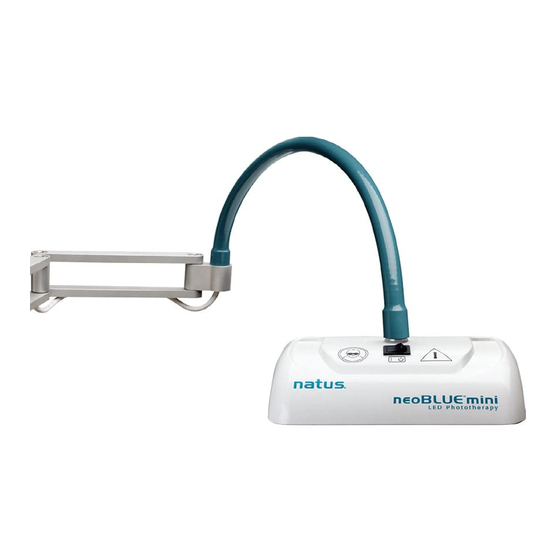
Table of Contents
Advertisement
Quick Links
Advertisement
Table of Contents

Summary of Contents for natus neoBLUEmini
- Page 1 ____________________________________________________________ User Manual...
- Page 2 © 2006 Natus Medical Inc. All rights reserved. This manual may not be reprinted or copied in whole or in part without written consent from Natus Medical Inc. The content of this manual may change without notice. Natus Medical Inc.
-
Page 3: Table Of Contents
Contents Product Description 1.1 Intended Use 1.2 Physical Characteristics 1.3 Light Source 1.4 Adjustable Arm 1.5 Power Requirements and Accessories 1.6 Accessory Pack 2 Safety Information 2.1 Explanation of Terminology 2.2 General Safety Information 2.3 Safety Symbols 3 Components and User Controls 3.1 Components 3.2 User Controls 4 Assembly and Operating Instructions... -
Page 4: Product Description
Product Description The neoBLUE mini LED Phototherapy System consists of two components – the neoBLUE mini phototherapy light source and the adjustable arm with pole mount. 1.1 Intended Use The neoBLUE mini LED Phototherapy System is intended for the treatment of neonatal hyperbilirubinemia. -
Page 5: Adjustable Arm
Warning! Incorrect use of the light, or the use of parts and accessories that are not manufactured or supplied by Natus Medical Inc., can damage the light, and may cause injury to the patient and/or user. - Page 6 Warning! Attachment of Arm with Pole Mount: When attaching the light to any floor standing pole, the user must validate that EN 60601-1/UL2601-1 standards for stability in normal use is met. Warning! Attachment of Arm with Pole Mount: Ensure that the pole mount is properly seated around the pole prior to use to prevent slippage during use.
-
Page 7: Safety Symbols
Warning! Clear Lens: Do not use the light if the lens is missing or damaged. The lens is a plastic shield that provides electrical safety by protecting the baby, operator and the unit from incidental debris or fluids. Warning! Photosensitive Drugs: The light generated can degrade photosensitive medications. - Page 8 Manufacturer Natus WEEE Directive (Waste from Electrical and Electronic Equipment Directive) Symbol – Product should not be disposed of in normal waste ® neoBLUE mini System User Manual P/N 051440D...
-
Page 9: Components And User Controls
3. Components and User Controls 3.1 Components The neoBLUE mini phototherapy system includes the components shown in the following figure. Main Device Components Light Enclosure: The light enclosure can be tilted by grasping the device and/or gooseneck. Gross movements should be made with the arm while finer adjustments can be made with the light enclosure and gooseneck. -
Page 10: Assembly And Operating Instructions
4. Assembly and Operating Instructions 4.1 Setting Up the Device Attach the arm only to the manufacturer’s specified location on the radiant warmer or incubator. If an open bed or bassinet is being used, attach the arm to a free-standing pole that meets the requirements for safety listed below. -
Page 11: Administering Phototherapy
The adjustable arm allows positioning of the light in multiple positions. The arm is adjustable in five locations. The light can be positioned vertically by moving it along the pole. The following table outlines the changes in surface area and intensity based on distance from the light to the infant. -
Page 12: Troubleshooting Guide
5. Troubleshooting Guide Note: neoBLUE mini device Service Manual available separately. In the USA, contact Natus Technical Service at +1 (888)-496-2887 or E-mail: technical_service@natus.com. International Support - Please contact your local Distributor. Distributor locations can be found at www.natus.com Warning! Disconnect power cord before opening the light for repair... -
Page 13: Routine Cleaning & Maintenance
6. Routine Cleaning and Maintenance Checking the Light Intensity It is recommended that the intensity of the light be checked per hospital protocol or at least every six months. Have a qualified technician test the intensity level and readjust the intensity potentiometer to achieve the desired output, if required Caution: Only qualified personnel should perform service and repair. -
Page 14: Technical Reference
7. Technical Reference The following graph shows the normalized spectra of the blue LEDs and the spectral sensitivity of the spectrophotometer. Measurements for this light were made using a standard spectrophotometer. The intensity of the light is set at the factory to 30-35 µW/cm 2 /nm at a 12 inch (30.5 cm) distance from the light enclosure. -
Page 15: Specifications
8. Specifications Light Source Blue and Yellow LEDs Wavelength Blue: Peak between 450 and 470 nm Yellow: Peak between 585 and 595 nm Intensity Peak central intensity at 12 inches (30.5 cm) 30-35 µW/cm 2 /nm Variation in intensity over 6 hrs <... -
Page 16: Measuring The Neoblue Mini Light With A Photometer
To adjust the neoBLUE mini light to the desired intensity when changing the distance, please refer to the service manual. The light intensity output of the neoBLUE mini device is measured at Natus prior to shipment with the Ohmeda BiliBlanket® Meter II. Because your facility may use a different photometer to measure the light intensity output, it is necessary to understand how your reading correlates to the Ohmeda reading.
















Need help?
Do you have a question about the neoBLUEmini and is the answer not in the manual?
Questions and answers